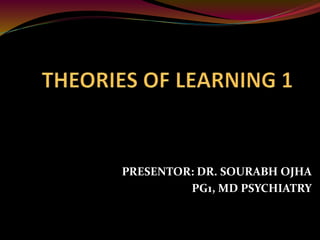
Theories of learning.pptx
- 1. PRESENTOR: DR. SOURABH OJHA PG1, MD PSYCHIATRY
- 2. DEFINITION LEARNING: Relatively permanant change in behavior and knowledge resulting from repeated practice, both the environment and the behavior interact to produce the learned change. CONDITIONING: That process in which an ineffective object or situation becomes so much effective that it makes hidden response apparent.
- 3. LEARNING THEORIES Classical conditioning Operant conditioning Social learning
- 4. CLASSICAL CONDITIONING Classical conditioning is a type of learning in which a stimulus acquires the capacity to evoke a response, that was originally evoked by another stimulus. First described in 1900 by Ivan Pavlov, also called Pavlovian conditioning.
- 5. IVAN PAVLOV - Russian physiologist (1849-1936) Gave classical conditioning theory Won Nobel prize in 1904 for his discovery in digestive system. Classically conditioned dogs using the salivary reflex.
- 8. Process of classical conditioning Before conditioning The unconditioned stimulus unconditioned response The conditioned stimulus no response Bell no response (CS) Meat powder response (US) salivation
- 9. During conditioning Presentation of bell (CS) salivation (UCR) Presentation of food(UCS) (meat powder) After conditioning Presentation of bell alone(CS) salivation(CR)
- 10. The conditioned stimulus (CS) is a previously neutral stimulus that has, through conditioning, acquired the capacity to evoke a conditioned response. The conditioned response (CR) is a learned reaction to a conditioned stimulus that occurs because of previous conditioning.
- 11. The unconditioned stimulus (US) is a stimulus that evokes an unconditioned response without previous conditioning. The unconditioned response (UR) is an unlearned reaction to an unconditioned stimulus that occurs without previous conditioning.
- 12. Key features of classical conditioning EXTINCTION Once the conditioned response has been established presentation of CS alone without the UCS leads to gradual disappearance of the CR . SPONTANEOUS RECOVERY If CS is reintroduced after extinction has been produced , the CR reappears but the response is weak and fragile
- 13. GENERALIZATION Refers to tendency to respond to stimuli that are similar to the original CS DISCRIMINATION When an organism that has learned a response to specific stimulus does not respond in the same way to new stimuli that are similar to the original stimulus
- 14. HIGH ORDER CONDITIONING After classical conditioning has taken place, the CS can be paired with second CS and after series of trial second CS acquired the conditioning property of US COUNTER CONDITIONING If established CS is paired with a new CS which elicit the new response that is incompatible with the with old one ,leads to the suppression of original CR.
- 15. Conditioning in anxiety disorders Classical fear conditioning can contribute to phobias (in which specific objects may be associated with a traumatic US), as well as other anxiety disorders, such as panic disorder and posttraumatic stress disorder (PTSD). In panic disorder, people who have unexpected panic attacks can become anxious about having another one. In this case, the panic attack (the US or UR) may condition anxiety to the external situation in which it occurs (e.g., a crowded bus)
- 16. also internal (“interoceptive”) CSs created by early symptoms of the attack (e.g., dizziness or a sudden pounding of the heart). These CSs may then evoke anxiety or panic responses. Panic disorder may begin because external cues associated with panic can arouse anxiety, which may then exacerbate the next unconditional panic attack and/or panic response elicited by an interoceptive CS.
- 17. Treatment of substance abuse: Cue exposure treatment for alcoholic persons and drug addicts is based on the principle of extinction—the procedure of presenting the conditioned stimulus in the absence of the unconditioned stimulus. Doing so results in the elimination of the conditioned response when the conditioned stimulus no longer predicts its occurrence. Thus patients with alcohol dependence are presented with alcohol-related cues such as the sight and the smell of alcohol, which reliably elicit craving, without being allowed to drink alcohol (the unconditioned stimulus).
- 18. Application of classical conditioning Flooding Aversion therapy Systemic desensitization
- 19. FLOODING Is an exposure therapy that utilizes the extinction process and reduce anxiety. In flooding patient is exposed to fear producing stimuli. Flooding is accompanied by response prevention . Over the time anxious responses are reduced . Flooding can be carried out in vivo or in imagery.
- 20. AVERSION THERAPY It involves pairing of an unpleasant or painful stimulus with the target behavior The technique has been employed mainly with substance abuse Smoking is paired with injection which produce nausea and vomiting, Disulfiram for alcohol produce similar effects and causes aversion.
- 21. SYSTEMIC DESENSITISATION Developed by Joseph wolpe (1958) for the treatment of phobia. The mechanism underlies is counter conditioning. It involves creating a hierarchy. Progressive deep muscle relaxation is taught. A state of relaxation is then paired with the presentation of the feared object in gradual fashion using imagery
- 22. THANK YOU